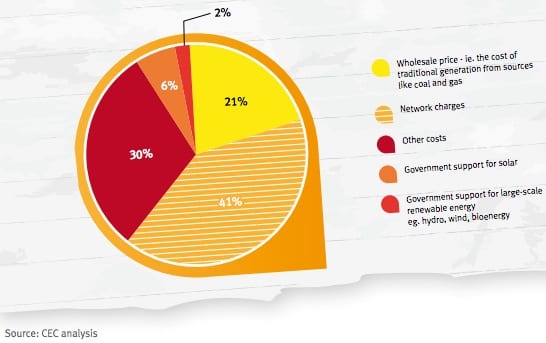Queensland axes 8c/kWh solar feed-in tariff
Queensland’s Newman government has continued its “war on solar”, confirming it will axe the state’s 8c/kWh rooftop solar feed-in tariff at the end of June, leaving solar households with the challenge of negotiating a tariff with their electricity retailer.
The move by the government – which will affect 40,000 households, and any new rooftop solar adopters – was expected, and was justified by claims it would “lift the cost burden” from electricity network businesses and put “downward pressure” on electricity prices for all Queenslanders.
In a refrain taken straight from the Campbell Newman songbook, Queensland energy minister Mark McArdle said in a media release on Thursday that the carbon tax and renewable energy targets had driven electricity prices “much higher than they should be.” No mention of the soaring cost of the government-owned networks.
“Left unchecked, the 8 cent feed-in tariff would cost Queensland households and businesses an extra $110 million on their power bills over the next six years,” McArdle said. Presumably, he was expecting the number of Queensland households to increase dramatically, because the current 40,000 households on the 8c/kWh tariff would need to export nearly all their generation to meet that figure.
Critics say the changes – announced as part of a series of reforms to the state’s Solar Bonus Scheme – mean that the 40,000 solar households in Queensland will be left at the mercy of the state’s electricity retailers, who will assume responsibility for setting and offering solar energy tariffs.
“This is incredibly unfair,” said Lindsay Soutar, from Solar Citizens. “It is obvious that it will be difficult for individual households to get a good deal from their power company. They simply don’t have the negotiating power. When retailers set the rules, solar owners lose.”
As one solar industry expert pointed out, the Queensland government was unable to win its fight with retailers over pricing, so what chance would an individual household have? Victoria, WA, and South Australia all have mandated minimum tariffs. NSW is the only state that doesn’t, and even IPART found that customers were not getting a good deal – most well below the recommended rate. Many households are offered nothing.
Rhys Clay from Local Energy Solar said that while he disagreed with the Newman government’s approach to limiting the solar feed-in tariff, the changes would at least help encourage customers to install energy storage, and save their surplus solar energy for use later in the night.
“It is our hope that the QLD goverment reforms electricity pricing to accurately reflect the true cost of electricity (higher prices at peak times) as this will help facilitate a shift energy efficiency and storage which in turn will benefit the network,” Clay said.
The Queensland government said customers of Energex would no longer have a government regulated rate, but will be able to negotiate a tariff with their retailer. Ergon Energy customers, meanwhile, will continue to be paid a tariff set by the Queensland Competition Authority until “there is enough retail competition in regional areas to make solar more self-sufficient.”
“These reforms will mean electricity retailers will pay any newly negotiated solar tariff direct to users,” McArdle said. “These are common-sense decisions that will produce a positive outcome for existing customers on the 8 cent rate, as well as new solar owners.”
This latest solar tariff cut follows the slashing of the 44c/kWh net tariff in 2012, when Campbell Newman’s decision to provide a month-long window to take advantage of the 44c rate inadvertently sparked a massive rush for rooftop solar in Queensland.
Today, McArdle said the 44c/kWh solar feed-in tariff would be kept in place for the around 284,000 Queensland households who signed up to it before it was closed.
The solar industry has argued that government support for rooftop solar adds a negligible amount to the average household electricity bill, with more than two-thirds of price rises caused by factors completely unrelated to any green schemes, such as soaring generation costs, network costs, and increased costs from retailers and billing centres.
Price breakdown of average Australian household electricity bill
Last year, a Queensland Competition Authority report recommended a 13.5 per cent increase in solar tariffs from July 1, 2014, and predicted that the impact of the carbon price, even if not repealed, would actually go down, as would any impact from renewable energy schemes.
In an interview with the Courier Mail, McArdle said axing the 8c FiT in the state’s southeast would foster competition ahead of the removal of regulated prices in July 2015.
“I don’t think (retailers) will abandon solar customers, because paying the feed-in tariff is part of their market strategy to attract customers to their contracts,” he said.
“Customers can then start to play retailers off against each other to get a better deal, and we may well find that the feed-in tariff increases with competition.’’


